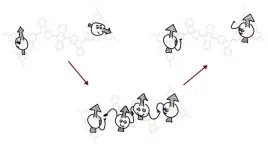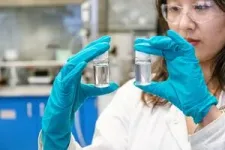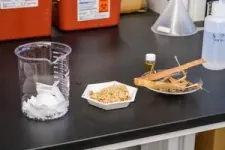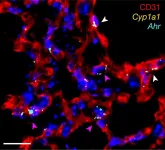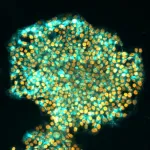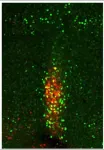(Press-News.org) Researchers have found a way to control the interaction of light and quantum ‘spin’ in organic semiconductors, that works even at room temperature.
Spin is the term for the intrinsic angular momentum of electrons, which is referred to as up or down. Using the up/down spin states of electrons instead of the 0 and 1 in conventional computer logic could transform the way in which computers process information. And sensors based on quantum principles could vastly improve our abilities to measure and study the world around us.
An international team of researchers, led by the University of Cambridge, has found a way to use particles of light as a ‘switch’ that can connect and control the spin of electrons, making them behave like tiny magnets that could be used for quantum applications.
The researchers designed modular molecular units connected by tiny ‘bridges’. Shining a light on these bridges allowed electrons on opposite ends of the structure to connect to each other by aligning their spin states. Even after the bridge was removed, the electrons stayed connected through their aligned spins.
This level of control over quantum properties can normally only be achieved at ultra-low temperatures. However, the Cambridge-led team has been able to control the quantum behaviour of these materials at room temperature, which opens up a new world of potential quantum applications by reliably coupling spins to photons. The results are reported in the journal Nature.
Almost all types of quantum technology – based on the strange behaviour of particles at the subatomic level – involve spin. As they move, electrons usually form stable pairs, with one electron spin up and one spin down. However, it is possible to make molecules with unpaired electrons, called radicals. Most radicals are very reactive, but with careful design of the molecule, they can be made chemically stable.
“These unpaired spins change the rules for what happens when a photon is absorbed and electrons are moved up to a higher energy level,” said first author Sebastian Gorgon, from Cambridge’s Cavendish Laboratory. “We’ve been working with systems where there is one net spin, which makes them good for light emission and making LEDs.”
Gorgon is a member of Professor Sir Richard Friend’s research group, where they have been studying radicals in organic semiconductors for light generation, and identified a stable and bright family of materials a few years ago. These materials can beat the best conventional OLEDs for red light generation.
“Using tricks developed by different fields was important,” said Dr Emrys Evans from Swansea University, who co-led the research. “The team has significant expertise from a number of areas in physics and chemistry, such as the spin properties of electrons and how to make organic semiconductors work in LEDs. This was critical for knowing how to prepare and study these molecules in the solid state, enabling our demonstration of quantum effects at room temperature.”
Organic semiconductors are the current state-of-the-art for lighting and commercial displays, and they could be a more sustainable alternative to silicon for solar cells. However, they have not yet been widely studied for quantum applications, such as quantum computing or quantum sensing.
“We’ve now taken the next big step and linked the optical and magnetic properties of radicals in an organic semiconductor,” said Gorgon. “These new materials hold great promise for completely new applications, since we’ve been able to remove the need for ultra-cold temperatures.”
“Knowing what electron spins are doing, let alone controlling them, is not straightforward, especially at room temperature,” said Friend, who co-led the research. “But if we can control the spins, we can build some interesting and useful quantum objects.”
The researchers designed a new family of materials by first determining how they wanted the electron spins to behave. Using this bottom-up approach, they were able to control the properties of the end material by using a building block method and changing the ‘bridges’ between different modules of the molecule. These bridges were made of anthracene, a type of hydrocarbon.
For their ‘mix-and-match’ molecules, the researchers attached a bright light-emitting radical to an anthracene molecule. After a photon of light is absorbed by the radical, the excitation spreads out onto the neighbouring anthracene, causing three electrons to start spinning in the same way. When a further radical group is attached to the other side of the anthracene molecules, its electron is also coupled, bringing four electrons to spin in the same direction.
“In this example, we can switch on interaction between two electrons on opposite ends of the molecule by aligning electron spins on the bridge absorbing a photon of light,” said Gorgon. “After relaxing back, the distant electrons remember they were together even after the bridge is gone.
“In these materials we’ve designed, absorbing a photon is like turning a switch on. The fact that we can start to control these quantum objects by reliably coupling spins at room temperature could open up far more flexibility in the world of quantum technologies. There’s a huge potential here to go in lots of new directions.”
“People have spent years trying to get spins to reliably talk to each other, but by starting instead with what we want the spins to do and then the chemists can design a molecule around that, we’ve been able to get the spins to align,” said Friend. “It’s like we’ve hit the Goldilocks zone where we can tune the spin coupling between the building blocks of extended molecules.”
The advance was made possible through a large international collaboration – the materials were made in China, experiments were done in Cambridge, Oxford and Germany, and theory work was done in Belgium and Spain.
The research was supported in part by the European Research Council, the European Union, the Engineering and Physical Sciences Research Council (EPSRC), part of UK Research and Innovation (UKRI), and the Royal Society. Richard Friend is a Fellow of St John’s College, Cambridge.
END
Switching ‘spin’ on and off (and up and down) in quantum materials at room temperature
2023-08-16
ELSE PRESS RELEASES FROM THIS DATE:
Research finds that molecules in vegetables can help to ease lung infection
2023-08-16
Francis Crick Institute press release
Under strict embargo: 16:00hrs BST 16 August 2023
Peer reviewed
Experimental study
Animals
Research finds that molecules in vegetables can help to ease lung infection
Researchers at the Francis Crick Institute have found that molecules in vegetables like broccoli or cauliflower help to maintain a healthy barrier in the lung and ease infection.
The AHR – aryl hydrocarbon receptor – is a protein found at barrier sites like the gut and the lung. Natural molecules in cruciferous vegetables – for example, kale, cauliflower, broccoli, or cabbage – are dietary ...
Collecting clean water from fog
2023-08-16
In countries such as Peru, Bolivia and Chile, it’s not uncommon for people who live in foggy areas to hang up nets to catch droplets of water. The same is true of Morocco and Oman. These droplets then trickle down the mesh and are collected to provide water for drinking, cooking and washing. As much as several hundred litres of water can be harvested daily using a fog net only a few square metres in area. For regions with little rain or spring water, but where fog is a common occurrence, this can be a blessing.
One crucial drawback with this method, however, ...
Mental illness following physical assault among children
2023-08-16
About The Study: Children who experienced assault had, on average, a 2 times higher risk of receiving a mental illness diagnosis and were more likely than children who had not experienced assault to present to acute care for mental illness. Early intervention to support mental health of assaulted children is warranted, particularly in the first year following assault.
Authors: Natasha Ruth Saunders, M.D., M.Sc., of the Hospital for Sick Children in Toronto, is the corresponding author.
To ...
Prevalence, factors associated with vaping CBD among adolescents
2023-08-16
About The Study: In this study of 28,000 middle and high school students, the prevalence of vaping cannabidiol (CBD) was high, particularly among e-cigarette users and Hispanic and sexual minority populations. The findings suggest that evidence-based educational campaigns, interventions, and public policy changes are needed to reduce the harmful health outcomes possible with vaping CBD among developing youths.
Authors: Hongying Daisy Dai, Ph.D., of the University of Nebraska Medical Center in Omaha, is the corresponding author.
To access the embargoed study: Visit our For The Media website at this link https://media.jamanetwork.com/
(doi:10.1001/jamanetworkopen.2023.29167)
Editor’s ...
Patterns in cancer incidence among people younger than age 50
2023-08-16
About The Study: The incidence rates in the U.S. of early-onset cancer (younger than age 50) increased from 2010 to 2019 in this study of 562,000 patients. Although breast cancer had the highest number of incident cases, gastrointestinal cancers had the fastest-growing incidence rates among all early-onset cancers. These data may be useful for the development of surveillance strategies and funding priorities.
Authors: Daniel Q. Huang, M.B.B.S., M.M.E.D., and Cheng Han Ng, M.B.B.S., of the National University of Singapore, are the corresponding authors.
To access the embargoed study: ...
Scientists find way to wipe a cell’s memory to better reprogram it as a stem cell
2023-08-16
In a groundbreaking study published today in Nature, Australian scientists have resolved a long-standing problem in regenerative medicine. Led by Professor Ryan Lister from the Harry Perkins Institute of Medical Research and The University of Western Australia and Professor Jose M Polo from Monash University and the University of Adelaide, the team developed a new method to reprogram human cells to better mimic embryonic stem cells, with significant implications for biomedical and therapeutic uses.
In a revolutionary advance in the mid-2000s, it was ...
Paternal depression and risk of depression among offspring
2023-08-16
About The Study: Paternal depression was associated with subsequent offspring depression in this systematic review and meta-analysis including 7.1 million father-child dyads from 16 observational studies. This finding shows the intergenerational transmission of mental health problems and suggests that mental health interventions benefit not only the patient but also the family as a whole, including both parents.
Authors: Berihun Dachew, Ph.D., of Curtin University in Perth, Australia, is the corresponding author.
To ...
Normal graft function after pig-to-human kidney xenotransplant
2023-08-16
About The Study: The findings from this case series show that pig-to-human xenotransplant provided life-sustaining kidney function in a deceased human with chronic kidney disease. Future research in living human recipients is necessary to determine long-term xenograft kidney function and whether xenografts could serve as a bridge or destination therapy for end-stage kidney disease.
Authors: Jayme E. Locke, M.D., M.P.H., of the University of Alabama at Birmingham Heersink School of Medicine, is the corresponding author.
To access the embargoed study: Visit our For The Media website at this link https://media.jamanetwork.com/
(doi:10.1001/jamasurg.2023.2774)
Editor’s ...
Blood factor can turn back time in the aging brain
2023-08-16
Blood Factor Can Turn Back Time in the Aging Brain
Platelets are behind the cognitive benefits of young blood, exercise and the longevity hormone klotho
In a remarkable convergence, scientists have discovered that the same blood factor is responsible for the cognitive enhancement that results from young blood transfusion, the longevity hormone klotho, and exercise.
In a trio of papers appearing in Nature, Nature Aging and Nature Communications on August 16, 2023, two UCSF teams and a team from the University of Queensland (Australia), identify platelet ...
How cold temperatures trigger the brain to boost appetite
2023-08-16
LA JOLLA, CA—Neuroscientists at Scripps Research have identified brain circuits that make mammals want to eat more when they are exposed to cold temperatures.
Mammals automatically burn more energy to maintain normal body temperature when exposed to cold. This cold-activated increase in energy expenditure triggers an increase in appetite and feeding, although the specific mechanism controlling this had been unknown. In the new study, reported on August 16, 2023, in Nature, the researchers identified a cluster of neurons that work as a “switch” for this cold-related, food-seeking behavior in mice. The discovery could lead to potential ...
